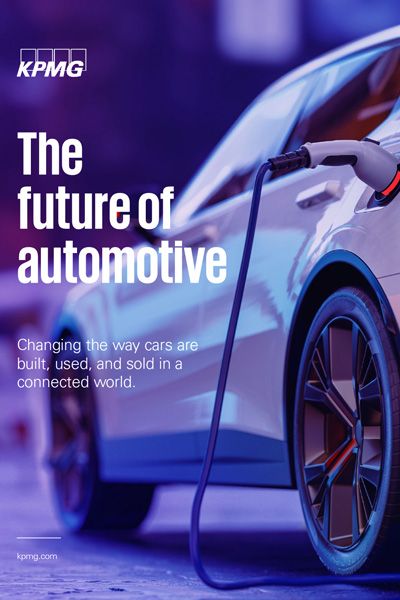In the past few years automakers, and everyone in the automotive ecosystem — from component manufacturers to design engineers to marketing and finance executives to investors, dealers, and customers - have been confronted with massive change.
Future success for automakers will be determined by their ability to adapt to five categories of change that require strategic responses and changes in business and operating models.
Signals of change
- How cars work. The shift to electric power trains leaves traditional internal combustion engine (ICE) automakers furiously pursuing electric vehicle (EV) strategies—and facing new competitors.
- How cars are built. The shift to EVs requires new ways of building cars—with completely different components and technologies.
- How cars are used. New ownership and usage models like ride hailing, ride sharing, and subscriptions continue to gain traction, with vehicles used on an “as-a-service” basis.
- How cars are sold. Consumers have been shopping for cars online for years. Now they want to complete all their other vehicle-related transactions online, too.
- How the industry is regulated. Policy and regulatory changes are critical to EV transition. Countries and states have set deadlines for ending ICE vehicle sales.
In the Future of Automotive report, KPMG professionals look at how these changes create eight strategic imperatives. To fulfil these strategic imperatives, KPMG professionals believe that companies will need to become “connected enterprises”—organizations that use data and digital technology to function more smoothly, develop innovative products, connect with customers and suppliers, make rapid decisions with confidence, and give employees the tools to succeed.
imperatives
- As cars become ‘computers on wheels’, more value comes from digital technology design and software.
- Manufacturing is going modular, with less in-house production and greater focus on design and assembly.
- The shift to EV as well as supply chain challenges are causing a rethink of manufacturing footprints.
- EVs and ICE vehicles have different requirements.
- Automakers are separating EV, ICE and commercial businesses.
- JVs are also emerging to share the cost of EV development.
- Connected vehicle services offer revenue streams for OEMs.
- Automakers can strengthen customer relationships via infotainment.
- B2B revenues from fleet management technology, tax and expense management, and software upgrades are possible.
- Subscription models are expected to grow rapidly with a wide range of options, including time- or mileage-based pricing, insurance and maintenance.
- OEMs offer subscriptions to ride-sharing and/or mobility services, while some owners could have the option to lend their vehicles to public ride-sharing services.
- New mobility entrants bring competition and partnership opportunities.
- Customers buy direct from OEMs with vehicles delivered through dealers.
- Recent US consolidation has seen a rise in brand-agnostic digital mega-dealers.
- Shifting from traditional dealership models to direct sales is a major operational and cultural change.
- Aftermarket services improve customer experience, with remote services like maintenance and spare parts delivered at home or at hubs.
- 3D printing makes parts available faster and closer to the customer.
- OEMs could own the entire aftermarket experience or outsource to third parties.
- Increasing demand for financing presents opportunities to grow captive finance businesses.
- Financing remains a revenue source for dealers and OEMs as they sell more vehicles direct and become one-stop-shops for vehicle services.
- Fleet management services, vehicle insurance, extended warranty, and payment processing offer further revenue opportunities.
- Automakers struggle to attract and retain the talent to design and build connected, electric vehicles.
- Some OEMs have set up R&D and design shops in Silicon Valley and recruited technology leaders.
- The sector needs to adopt Silicon Valley mindsets and ways of working, reduce working hours and improve employee benefits.
KPMG Connected Enterprise
KPMG professionals can help you harness technology to build a connected enterprise. That's an enterprise where your front, middle and back offices are aligned. An enterprise where you're more connected with your customers, employees and business partners. An enterprise that enables you to respond quickly to market signals and pivot to help seize opportunities as they arise.
KPMG Connected Enterprise is a digital transformation approach, that’s industry-specific and customer-centric. It helps focus critical processes, functions, and relationships of a business on meeting customer expectations, creating business value and driving sustainable growth in a digital world.
Organizations that invest purposefully in these capabilities are twice as likely to meet customer expectations, achieve their objectives and deliver return on investment.*
You can discover how connected your organization is by using the diagnostic tool. It assesses you against industry best practice and highlights the opportunities and challenges that may affect your ability to become a connected enterprise.
- 2xImpact
*Base: 1,299 professionals involved with customer strategy decisions
Source: A commissioned study conducted by Forrester Consulting on behalf of KPMG, 2018. The research was conducted on a sector specific basis. Each capability is enabled by five level two capabilities.
Learn more about KPMG firms' automotive practice or contact a KPMG professional who is ready to help you address new challenges and drive growth.
Related insights
Connect with us
- Find office locations kpmg.findOfficeLocations
- kpmg.emailUs
- Social media @ KPMG kpmg.socialMedia





